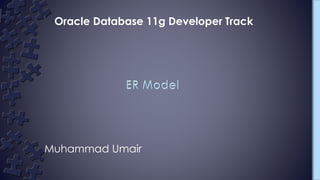Er model
- 1. Muhammad Umair Oracle Database 11g Developer Track
- 2. âš Database Creation â Developers creates database conceptually, whereas DBMS creates database physically. â At conceptual level, database is consisting of a set of objects (like tables) whereas at physical level database is a set of files on hard disk âš Data Model â A set of concepts used to describe data of a organization at a higher level
- 3. âš Entity Relationship Model (ER Model) â A data model used to describe data of an organization in the form of entities and their association âš Relational Model â A data model used to describe data of an organization in the form of relations âš Physical Data Model â A data model that is at the lowest level and can be converted to DBMS language directly
- 4. âš Entity â A group of objects having some characteristics about which an organization wants to maintain data e.g. â Students, Employee, Departments, Faculty, courses, lab, â Library, degree etc. â Entity can be person, place, thing, event or a concept. âš Entity Instance â Single occurrence of a Entity
- 5. âš Attribute â An attribute is a characteristic of an entity about which organization is interested âš Types of Attributes â Composite Attribute âš An attribute that is divided into more attributes e.g. âš Date of birth can be divided into day, month, year. âš Qualification can be divided into degree-name, university, passing year, %age
- 6. â Simple Attribute âš An attribute that can not divided into more attributes e.g. âš Gender (Male/Female), Salary â Multi-valued Attributes âš An attribute that can hold more then one value for a single entity instance e.g. âš Cell no, email-id, Experience, Qualification etc. â Single-valued Attributes âš An attribute that can not hold more then one value for a single entity instance e.g. âš Father name, Salary, Gender, Designation etc.
- 7. â Derived Attribute âš An attribute that is not necessary to be stored on hard disk because its value can be calculated from some other attribute e.g. âš Age can be calculated from date of birth, GPA can be calculated from marks. â Non-Derived Attribute âš An attribute that is necessary to be stored on hard disk because its value can not be calculated from some other attribute e.g. âš Father Name etc.







